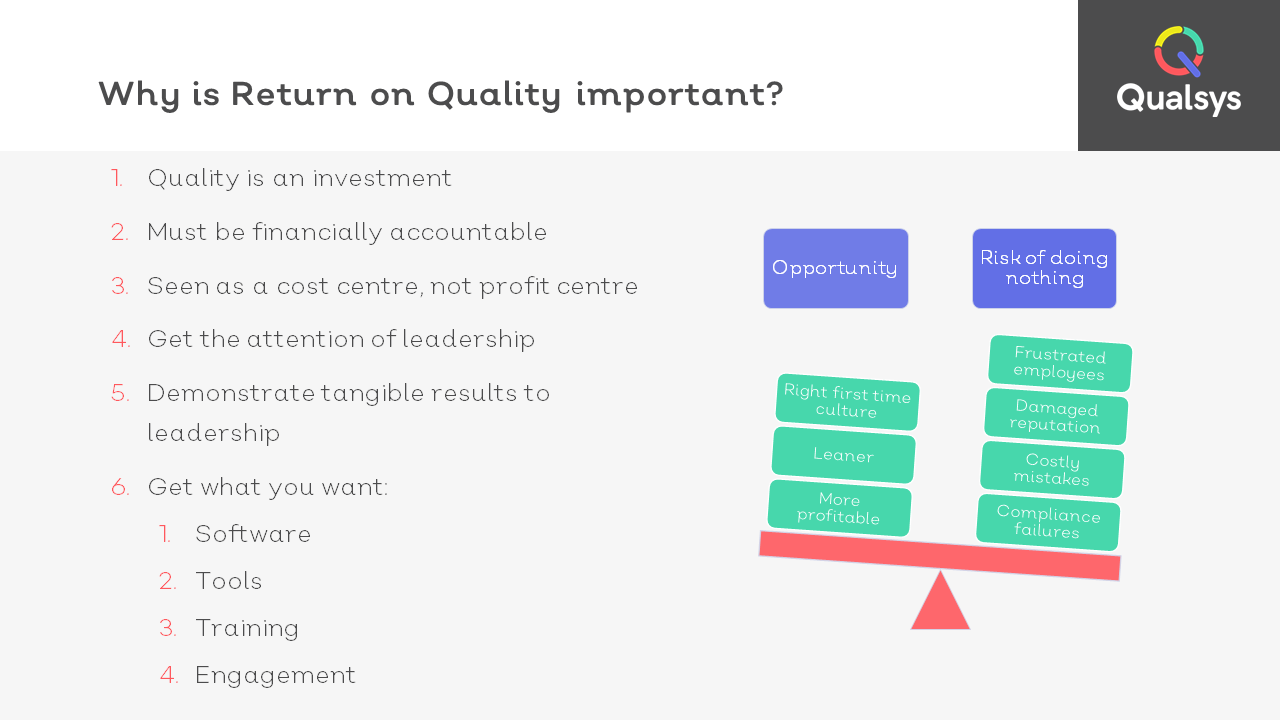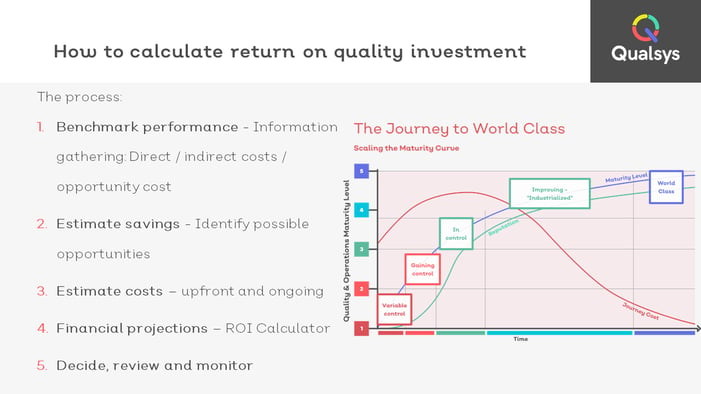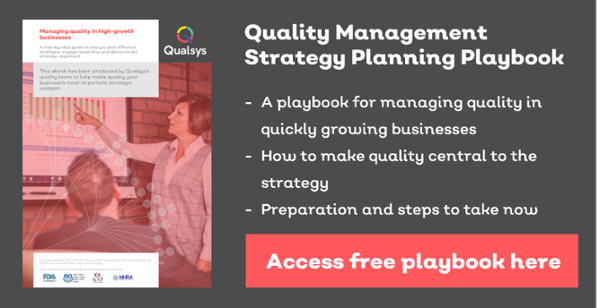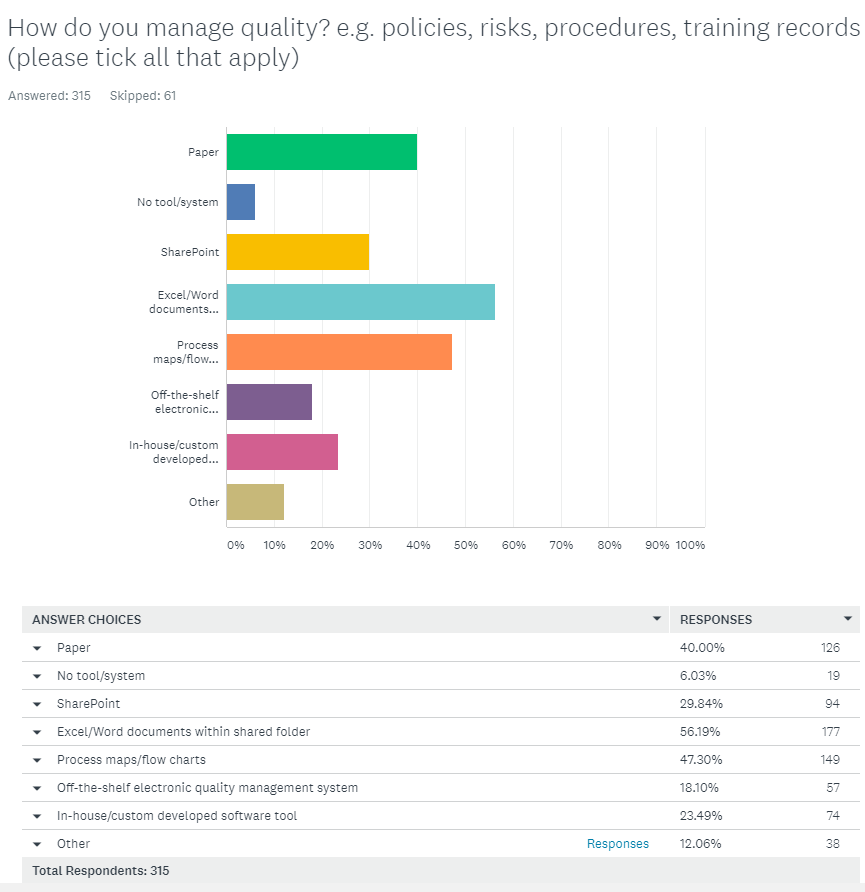Want to contribute to this article?
Return on quality is often dubbed the holy grail of quality management.
However, calculating and demonstrating return on quality is something many struggle to successfully implement as a strategic tool.
According to Qualsys's Global Governance, Risk and Compliance Trends Report 2018, only 10% of quality professionals say they feel confident they can calculate their department's return on investment.
In the past, quality professionals might be forgiven for an inability to measure their impact on the bottom line. A lack of sophisticated analytics tools made it impossible.
Quality teams would execute waste reduction initiatives which may lead to improved customer satisfaction, but they lacked the insights to demonstrate the value to senior management teams. They couldn't justify their department's worth - thus dubbed a "cost-centre" by the rest of the business.
Kate Armitage, Head of Quality Assurance at Qualsys, has been working with various international companies to use EQMS to calculate return on quality and transform the role to be a "profit-centre". She recently presented her tips at the CQI's Yorkshire event.
Below, we've shared her three mistakes to avoid when using return on quality.
The talk provoked a mixed reaction from the quality professionals in the audience - please share your thoughts in the comments section!

1) Giving too much information to senior management teams
Most quality professionals work across the organisation on multiple processes. This means there are incremental improvements everywhere in the business.
Kate warns against giving senior management teams every single KPI: "Leadership only want a dashboard with the most important indicators. If you've got a tool as powerful as EQMS, you can track on all these KPIs across the business without spending any time at all compiling the data. You can then customise KPI dashboards for your leadership team."
Kate recommended creating a list of the Critical to Quality (CTX) indicators. For example:
CTQ (Critical to Quality)
- Aligning product designs with customer requirements
- Meeting technical requirements
- Exceeding current market place quality levels
COQ (Cost of Quality)
- Reducing internal rejections
- Reducing warranty claims
- Eliminating unnecessary inspections
CTD (Critical to Delivery)
- Providing more rapid field service
- Minimising shipping damage
- Ensuring immediate response to customer questions
CTP (Critical to Process)
- Maximising preventative maintenance
- Eliminating redundant operations
- Minimising changeover times
Choose no more than five per quarter as your KPIs, but track trends and changes over time. The BI Dashboard by Qualsys will enable you to monitor trends, improvement and returns.

2) Not putting a monetary target / value in place
Many quality professionals say that they struggle to get the attention of leadership. In fact, a recent survey of 200+ industry leaders found this figure to be as high as 67%.
Kate explained it's difficult for leadership to prioritise their time, energy and effort. She said, "you need to be very clear when things are going well, where there are risks and where there are opportunities. Putting monetary values on a business case speaks their language."
Kate also suggested that if there are a team of quality experts, give them business training.
She added: "I trained all my quality staff on business. We often speak a different language from everyone else and expect them to understand. This helps quality to become better at marketing our own function - crucial for getting their attention and interest."

3) Realistic data
If you don't have the tools and systems in place, it can be tough and time consuming to calculate return on quality.
Kate said: "Think about a realistic metric to calculate ROQ. But don't simply collect the numbers and leave it there. What are you going to do once you've calculated Return on Quality? You need to set goals and objectives - then communicate them."

Collect data on:
- Prevention Costs: The money spent on preventing issues from occurring such as training, creation of standards, quality plans, etc.
- Appraisal Costs: The money spent on physically checking and auditing products, and systems.
- Internal Failure Costs: Costs incurred when a failure occurs in house; scrap, rework, time spent replacing product, etc.
- External Failure Costs: These usually cover everything from warranty costs to lost business.
What you should do now:
Download our High-Growth Quality Management Strategy Playbook for a step-by-step guide to plan effective strategies and engage leadership.









Share your thoughts on this article